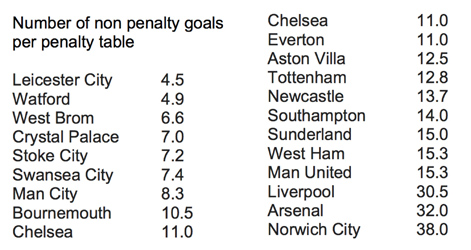At the start of the millennium, by which I mean the year 2001, not the commonly-used but erroneous 2000, it was said that Arsenal lacked a clinical finisher, a “fox in the box” to convert our free-flowing football into more end-product. Everton’s Francis Jeffers was hailed as the possible £8 million answer. As four goals in 22 games spread over three seasons attests, he wasn’t.
Talking of foxes, The Foxes of Leicester City topped not one, but two Premier League tables this season. Many congratulations are due concerning the only one that’s received worldwide publicity and acclaim, of course. But Leicester’s 5,000-1 triumph may never have been possible without featuring equally prominently in the second table, reproduced at the end.
A few seasons ago, when “Surley” was still patrolling the touchline at Old Trafford, from where he kept match officials in order, I gave some thought to the subject of penalties. Going back even further, it was said of the great Liverpool sides that they were often awarded penalties when most needed, to which their supporters replied that, as they scored more goals than other teams, it was not unreasonable to conclude that they spent more time ensconced in the opponent’s penalty area, therefore making penalties more likely.
Based thereon, I developed the idea of measuring a team’s potency by the number of goals they scored that did not come directly from penalties; non-penalty goals, if you will. Dividing the total non-penalty goals by the number of penalties awarded gives a ratio. This season, Arsenal have the dubious honour of being the only Premier League team not to be awarded a penalty on their home ground. I wonder when a team last finished second, or higher, without such assistance from either the referee or his two assistants (geddit?). But I digress.
Arsenal received two penalties, scoring one. So our 65-goal tally comprises 64 non-penalty goals. Divide this by the number of penalties awarded (two) gives a ratio of 32. In other words, we had to score 32 goals in order to be awarded a penalty, whether scored or not. Only relegated Norwich City - 39 goals, one penalty awarded and scored, giving a ratio of 38 - faired less favourably with the men in black when attacking. Previously mentioned Liverpool were third (30.5, to 1 decimal place).
And what of the new Premier League Champions? They scored 68 goals, including ten of the 13 penalties they were awarded. Congratulations to the season ticket holder who sits directly in front of me, by the way, who, on Valentine’s Day, backed them at 11-1 to get a penalty, which was duly awarded to, and despatched by, the cynical Jamie Vardy. I hope he bought his absent wife a bunch of flowers on the way home. But I digress. So Leicester’s ratio was 4.5, as they scored 58 non-penalty goals whilst being very lucky with the number of spot-kicks they were awarded (geddit?).
As to how many extra or fewer points teams received, depending on their standings in my derived table, it’s impossible to predict, and that’s before getting dragged into related imponderables such as momentum (gained or lost) and confidence (ditto).
1,026 goals were scored, including 74 from 91 penalties, meaning 952 non-penalty goals and an overall average of 10.5 (think Cherries).
The final table is reproduced on this page.







